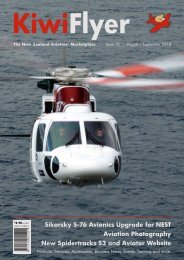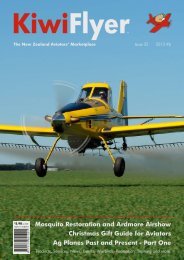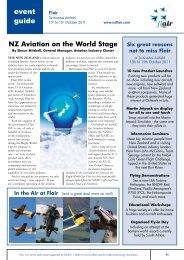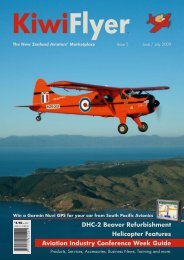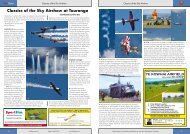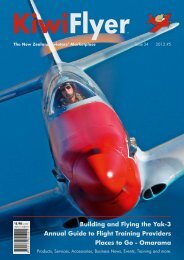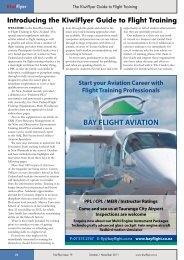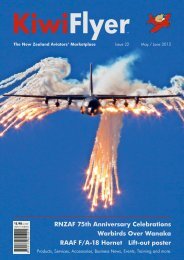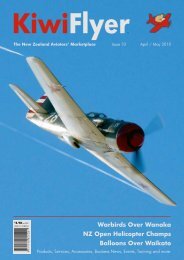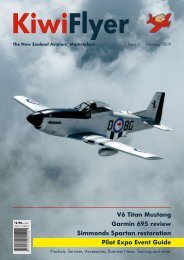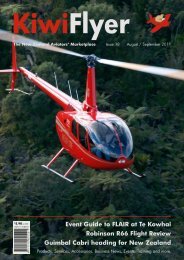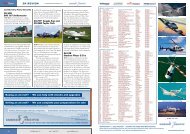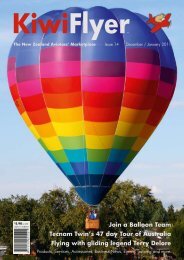Trans Tasman Furio Subsidised Aircraft Tracking Aero ... - KiwiFlyer
Trans Tasman Furio Subsidised Aircraft Tracking Aero ... - KiwiFlyer
Trans Tasman Furio Subsidised Aircraft Tracking Aero ... - KiwiFlyer
Create successful ePaper yourself
Turn your PDF publications into a flip-book with our unique Google optimized e-Paper software.
<strong>KiwiFlyer</strong> <strong>KiwiFlyer</strong> <strong>Aero</strong> Club Profiles <strong>KiwiFlyer</strong> <strong>Aero</strong> Club Profiles<br />
Free Training at the Dargaville <strong>Aero</strong> Club<br />
There are all sorts of interesting stories behind<br />
the network of aero clubs we are fortunate to<br />
have throughout New Zealand. From social<br />
gatherings of enthusiasts to ab-initio and advanced<br />
training, aero clubs are the glue that binds a<br />
diverse aviation community together. <strong>KiwiFlyer</strong><br />
welcomes contributions from readers about clubs<br />
and activities. Murray Foster<br />
and Allan Jessop provided this<br />
profile of their fast growing club at<br />
Dargaville.<br />
THE NORTHERN Wairoa<br />
<strong>Aero</strong> Club, more commonly<br />
known as the Dargaville <strong>Aero</strong><br />
Club, is situated alongside<br />
the Northern Wairoa River,<br />
literally a stones throw from<br />
the town. Whangarei, Kaipara<br />
Flats, Kaikohe, Kerikeri and<br />
Kaitaia airfields are all close<br />
at hand, creating excellent<br />
cross country training opportunities in<br />
uncontrolled airspace.<br />
Based on what was once a low lying<br />
swampy piece of land, club members have<br />
steadily developed a 1000m long runway of<br />
crushed limestone, with an adjacent grass<br />
runway of the same length that is used<br />
during the dry summer period.<br />
Approximately ten years ago, the club<br />
executive made a decision to change focus<br />
from general aviation to recreational flying.<br />
This resulted in the acquisition of club<br />
aircraft in the recreational category which<br />
members could hire for an<br />
affordable cost. Since making<br />
this decision, the club hasn’t<br />
looked back and is considered<br />
to be one of the fastest<br />
growing aero clubs in the<br />
country. Membership is about<br />
100, most of whom are from<br />
the local farming community.<br />
Club members are<br />
currently building a new<br />
clubhouse extension with<br />
funding assistance from the<br />
ASB Trust. When finished, it<br />
will be a facility of which club<br />
members and the community at large can<br />
be proud.<br />
<strong>Aircraft</strong> on line<br />
After considerable research by several<br />
members, the club chose the Italian Fly<br />
Synthesis Storch as its primary training<br />
aircraft. These are well proven, with more<br />
than 400 Storch trainers in use throughout<br />
Europe. Another attractive feature is<br />
that they are constructed of composite<br />
materials which are immune to the<br />
corrosive salt laden atmosphere of NZ’s<br />
western coastline. Currently there are 28<br />
students (hailing from Kaitaia to Timaru)<br />
flying the club’s Storch trainer and they are<br />
Dargaville <strong>Aero</strong> Club is located just across the river from the town.<br />
Studying for exams in the Dargaville <strong>Aero</strong> Club.<br />
Two students aged 15 and one aged 80.<br />
Dargaville <strong>Aero</strong> Club students pose with the club’s Storch trainer<br />
all avid fans of this lovely little machine.<br />
The club also has a Fly Synthesis Texan,<br />
a state-of-the-art carbon fibre machine that<br />
is a dream to fly and very popular with club<br />
members for comfortable cross country<br />
trips and training.<br />
For GA Pilot training, the club<br />
uses its own SPIFR Cessna 172 180hp<br />
“Superhawk” aircraft.<br />
Free Flight Training and Accommodation<br />
One of the unique features of the club<br />
is that all flying and theory tuition is given<br />
free of charge. All the student pays for is<br />
the cost of operating the aircraft. The club<br />
is able to do this due to its own farming<br />
operations (sheep, cattle and kumara), the<br />
profits of which are plowed<br />
back into airport maintenance<br />
and student tuition.<br />
Accommodation is free<br />
too. Students can live on the<br />
club premises during their<br />
training period and although<br />
basic, all that is required are<br />
sleeping bags and your own<br />
food. The club premises are<br />
currently being expanded to<br />
include a bunk room, new<br />
toilets and showers and also a<br />
well equipped kitchen.<br />
Well known Dargaville<br />
resident Murray Foster is the Chief<br />
Flying Instructor (and Authorised Testing<br />
Officer). Murray was a self employed<br />
Whangarei automotive garage proprietor<br />
but has recently sold the business and can<br />
now devote all his time to club students,<br />
offering flight training on a seven day basis<br />
rather than just at weekends. Murray has<br />
in fact been volunteering his time to teach<br />
students for over 30 years.<br />
The club’s other recreational instructor<br />
is Brian Taylor, a Northland Beef Farmer.<br />
Brian is also an authorised S.A.C. Test Pilot<br />
and Inspection Authority,<br />
specialised in checking out<br />
all types of recreational and<br />
homebuilt aircraft.<br />
Jill Mortensen is the club’s<br />
GA instructor. Jill is a very<br />
experienced B cat who has<br />
been training pilots for over<br />
30 years.<br />
Saturday Lunches<br />
The Club is famous<br />
amongst the aviation<br />
fraternity for its Saturday<br />
lunches, started 30 years ago<br />
and still held every Saturday at 12:30pm.<br />
These are open to anyone keen on flying<br />
and meeting a great bunch of like minded<br />
people who come from far and wide.<br />
For more information<br />
Phone Murray (daytime) on 09 439 8024,<br />
09 439 8984 or 0274 784 308.<br />
Email: the.workhouse@xtra.co.nz<br />
14 <strong>KiwiFlyer</strong> Issue 4 April / May 2009 www.kiwiflyer.co.nz<br />
Aviation Technology Specialists<br />
NZ Distributor for:<br />
TL Elektronic - Top of the line digital instrumentation<br />
and EFIS/EMS.<br />
ASL Camguard - Advanced engine oil supplement<br />
rated “ Top oil choice” by Aviation Consumer<br />
2008 Gear of the year<br />
The Cobra by UmeVoice - The World’s best noise<br />
cancelling technology<br />
Miracle Antenna - Power regulation and antenna<br />
technology<br />
Falcon Headsets - Affordable ANR and PNR<br />
For your aviation solution and pricing contact:<br />
Ryan Southam on 027 318 7934 or a/h (03) 208 4567<br />
email: info@criticalangle.co.nz www.criticalangle.co.nz<br />
Stratford <strong>Aero</strong><br />
Club Profile<br />
Stratford and Jodel Aviation Enthusiast Nick<br />
Furmage provides readers with the following profile<br />
on activities at Stratford <strong>Aero</strong>drome.<br />
IF YOU are not sure where we are, then<br />
look exactly in between Hawera in South<br />
Taranaki and New Plymouth on the<br />
Northern Taranaki Coast. You can’t miss<br />
our main navigation aid Mount Taranaki/<br />
Egmont (whichever you prefer) so getting<br />
lost should be fairly unlikely. Just don’t hit<br />
it. Most pilots are aware of the Stratford<br />
Gap which allows one to traverse the coast<br />
in inclement weather. This actually should<br />
not be taken lightly.<br />
Stratford <strong>Aero</strong>drome itself is 3 kms<br />
from Stratford on Flint Road East. We are<br />
essentially a recreational aerodrome and<br />
the base for Stratford <strong>Aero</strong> Club which<br />
incorporates the Stratford Sport Flyers.<br />
GA and microlights are catered for and<br />
microlight flight training is available.<br />
The field also hosts local Ag Operators,<br />
usually with either Fletcher or Cresco and<br />
we are home to the Taranaki Gliding Club.<br />
The local Radio Control enthusiasts are the<br />
Egmont Modellers Club. They operate off<br />
the end of runway 34 and will stop flying<br />
for you to land. Everyone seems to live in<br />
harmony and everything hums along nicely.<br />
There are a wide selection of aircraft<br />
based at Stratford ranging from RV-4’s,<br />
Jodels D-11 & D-9, Hughes 269 helicopter,<br />
Zenair Zodiacs, Sonareis, Minicab, Corby<br />
Starlet, Bantam, Challenger, Rans S-10<br />
Sakota, Titan Tornado, Avid, Alpi Pioneer,<br />
Cessna 180, Taylor Mono Plane, Pawnee<br />
and the list goes on.<br />
Stratford is now your only Shell AVGAS<br />
supplier in Taranaki. The next closest Shell<br />
supplies are a choice between Wanganui, Te<br />
Kuiti, Taumaranui or Taihape. The other<br />
option is New Plymouth if you don’t mind<br />
the Airways and landing fees, something<br />
you won’t have to consider at Stratford.<br />
We also have Shell Jet-A1. We do ask that<br />
you stop your engine on the grass and pull<br />
your plane to the pump. Helicopters should<br />
hover only as close as you really need to the<br />
pump.<br />
Someone is usually around the<br />
aerodrome on most days although we all<br />
work for a living so are not permanently<br />
open. Our clubrooms include coffee and<br />
tea facilities and if you’re very lucky the bar<br />
might be open at the end of a hard days<br />
flying.<br />
Stratford town with the airfield in the foreground.<br />
Summer conditions in Stratford are<br />
excellent for aviation. Taranaki itself is<br />
great to fly around and if you can, a trip<br />
over and around the mountain will be one<br />
of those magical moments. Flying down<br />
and around the coast is also a hoot. The<br />
waterfront in New Plymouth is worth a<br />
look and the friendly controllers will try<br />
to give you what you request if able. Bring<br />
a hat and your sunglasses though because<br />
some days are very hot.<br />
In winter we fly when we can as<br />
Stratford and the aerodrome do drain well<br />
although there is the odd soft patch. Give<br />
us a call and we will let you know where<br />
it is. You must stay aware of conditions<br />
as severe carb icing can occur here during<br />
winter. We don’t let the cold put us off<br />
though and enjoy quite a lot of winter<br />
flying as the weather permits.<br />
We also get a variety of visitors popping<br />
in such as the Airforce, Rescue helicopter,<br />
a range of Warbirds, and even the odd<br />
Australian.<br />
We have a selection of runways, the<br />
main vector being 27/09 with cross vector<br />
being 16/34. It’s not uncommon to have all<br />
three windsocks doing their own thing so<br />
just pick the strongest one. (The two 27/09<br />
based windsocks are the most reliable.) If<br />
you’re not sure then use 27/09 which has<br />
plenty of length. We advise once airborne<br />
to lower the nose and pick up speed, then<br />
continue climbing as you may sometimes<br />
experience some turbulence or windshear.<br />
Lastly, Stratford is surrounded by power<br />
pylons on all sides so good situational<br />
awareness is a must. They’re nothing to be<br />
afraid of although some might find this<br />
daunting on seeing them. We do ask that<br />
you do not over-fly the power station.<br />
We even have our name on the Roof<br />
NZSD. If you want to contact us we can<br />
be found on the aero club number 06 765<br />
6628 or I am more than happy to answer<br />
your queries directly. Phone Nick on 0275<br />
611 518. The Stratford <strong>Aero</strong> Club website<br />
is http://home.clear.net.nz/pages/millar/<br />
sd_aerodrome.htm<br />
Readers are invited to contribute a profile on their own <strong>Aero</strong> Club. Contact: editor@kiwiflyer.co.nz 15


